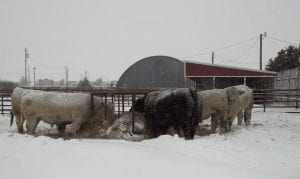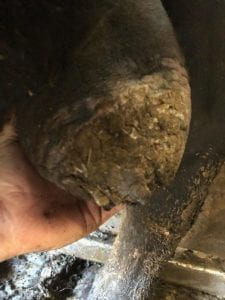By Sandy Johnson, Extension Beef Specialist, Colby

The impacts of the cold weather experienced in Kansas and surrounding states in early February will not be forgotten anytime soon and will leave lingering effects. The bull battery often does not get close attention during the winter months and some may have lacked adequate bedding or wind protection needed to prevent scrotal frostbite. Older bulls with pendulous scrotums seem more prone to issues than yearling bulls.
Bull breeding soundness exams (BSE) were first developed due to concerns regarding bull fertility after a series of storms during the winter of 1948 – 1949. According to the National Weather Service, a massive blizzard hit in early January that lasted 3 days and brought heavy snow, strong winds and cold temperatures. Additional storms through mid-February created huge snowdrifts. The effects of frostbite were then followed in 15 bulls impacted by the 1949 blizzard and 8 of the bulls refused service for 6 months.

Bull anatomy is designed to keep the testicles at a lower temperature than the body core and during cold weather the testicles are drawn closer to the body. However, compared to the rest of the body, the scrotum has less hair and thinner skin. When temperature regulation is not maintained, fertility is reduced. A bull suffering from frostbite may exhibit inflammation and swelling of the scrotum a few days after the weather event. The subsequent heat produced from the inflammation negatively effects the sperm cells maturing and being stored in the epididymis. The effects of frostbite may be temporary but may also result in permanent damage to sperm production. Scabs of various sizes may become evident as healing occurs, but the lack of a scab does not mean there is no injury. In more extreme cases, tissue adhesion can influence circulation in the scrotum and scrotal circumference can be reduced.
After a 1964 blizzard, eight veterinarians reported on 553 bulls with some level of frostbite. In this group, semen quality of 89% of bulls with severe frostbite was unsatisfactory, in bulls with moderate frostbite, 48% were satisfactory, 25% were questionable and 27% were unsatisfactory. Regardless of weather, bulls should have a breeding soundness exam before each breeding season. Several large data sets indicate that 10-30% of mature bulls fail BSE annually. It is recommended that breeding soundness exams be delayed 60 days following the occurrence of frostbite or illness with elevated body temperature. Exams earlier than this may result in culling bulls that may yet recover.
A breeding soundness exam consists of a physical evaluation, palpation of accessory sex glands and testes, and semen evaluation. The exam does not evaluate the wiliness to mate or serving capacity so observing activity during the breeding season is an important component of minimizing the risk of open cows.
If adjustments were not made for increased energy demands of cattle during the extreme cold weather, weight loss most likely occurred and would be greater in animals that were already thin. A study in Western Canada found fewer low body condition bulls (2, scale of 1 thin to 5 obese) had satisfactory semen quality compared to bulls in moderate condition (2.5 – 3.5). On the other end of the spectrum, fat in the scrotum interferes with the normal cooling process and is detrimental to semen quality. Bulls should be in good body condition, but not fat, in advance of the breeding season.
Finding out after the fact your bull was only a ‘cow companion’ during the breeding season is a costly problem. Schedule breeding soundness exams with your veterinarian so unsatisfactory breeders (cow companions) can be replaced before the breeding season begins.